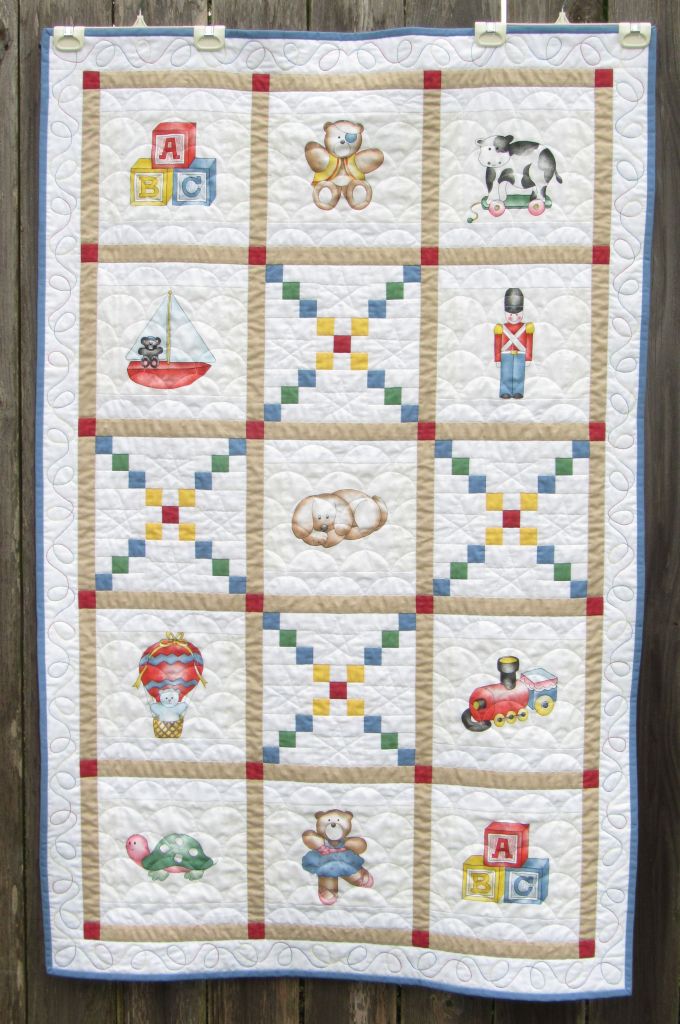What a huge relief that this 84″ x 84″ top is finally done and out of my sewing room.

When a friend showed me 20 applique blocks she found in her mom’s house after she died, I jumped at the chance to figure out how to put them together. My blind enthusiasm and eagerness to help quickly disappeared once I took a closer look and discovered that the blocks were not all the same size and were not square. Uh-oh.

This project languished in my sewing room from late 2022 to early February this year in a one-step-forward-four-steps-back fashion: lots of thinking, lots of marking, lots of pinning, hand basting, sewing, ripping (including my hair), an intolerable number of conversations with John about the math and geometry, and incessant measuring. The brain damage was real.
Complicating progress was the secondary pattern that clearly was intended in the final layout, achieved by arranging the blocks with the green gingham bases facing each other to create a center square-in-a-square.

Unfortunately, the angle of the gingham bases was not a consistent 45 degrees, making it difficult to achieve true square. Close was the best I could do.

Establishing a straight sewing line to create an acceptable looking square-in-a-square was a balancing act between having enough seam allowance and matching points.

Marking and basting before sewing didn’t always guarantee that the blocks would lie flat on the first try. Corrections usually created more trouble elsewhere.

Sashing was used to connect the four quadrants, with additional sashing to frame everything in my attempt to produce a finished center square. If I could get to that point, building out of the rest of the top would be easy.

I did my best to align the center of each quadrant with that of its neighbor, but the sashings measured different widths. It didn’t look great, but. . . . The measurement from the center of any given quadrant to the midpoint of any adjacent sashing was the same for all four quadrants. This was key to achieving a center that would be a true square.

One crazy issue cropped up when sewing the blue quadrant together. One of the blocks didn’t have enough fabric for a quarter-inch seam allowance so I had to create it.

Mostly out of fear, I took the precaution not to trim any of the seam allowances to one-quarter inch. To reduce bulk, I pressed open all the seam allowances forming each square-in-a-square. I kept thinking that if my friend didn’t like the finished top, at least I could take it apart and return all the blocks to her intact.

Also, if a seam allowance contained a selvage edge, it remained.

When the center was finally pieced and ready for the green border, there were so many markings on the wrong sides of the blocks and sashings, I ended up hand washing the center section to remove them before building out the rest of the top.

This project took forever because there were so many issues to work through that I would get frustrated and walk away for days, sometimes even weeks. When something you ordinarily love to do becomes more like a dreaded chore, shifting into avoidance mode is inevitable. In the interim, the guilt I felt when not working on it prevented me from sewing or quilting my own projects, so my quilting life has been a little strange these past 16 months.

Here are my three take-aways from this project:
- If hell were to freeze over, participation in a block exchange would still never be in my future.
- Quilting math is not difficult or mysterious when you can control it from the beginning.
- I have a profound regard for people who rescue unfinished quilts and blocks.
Thanks for stopping by!





























































